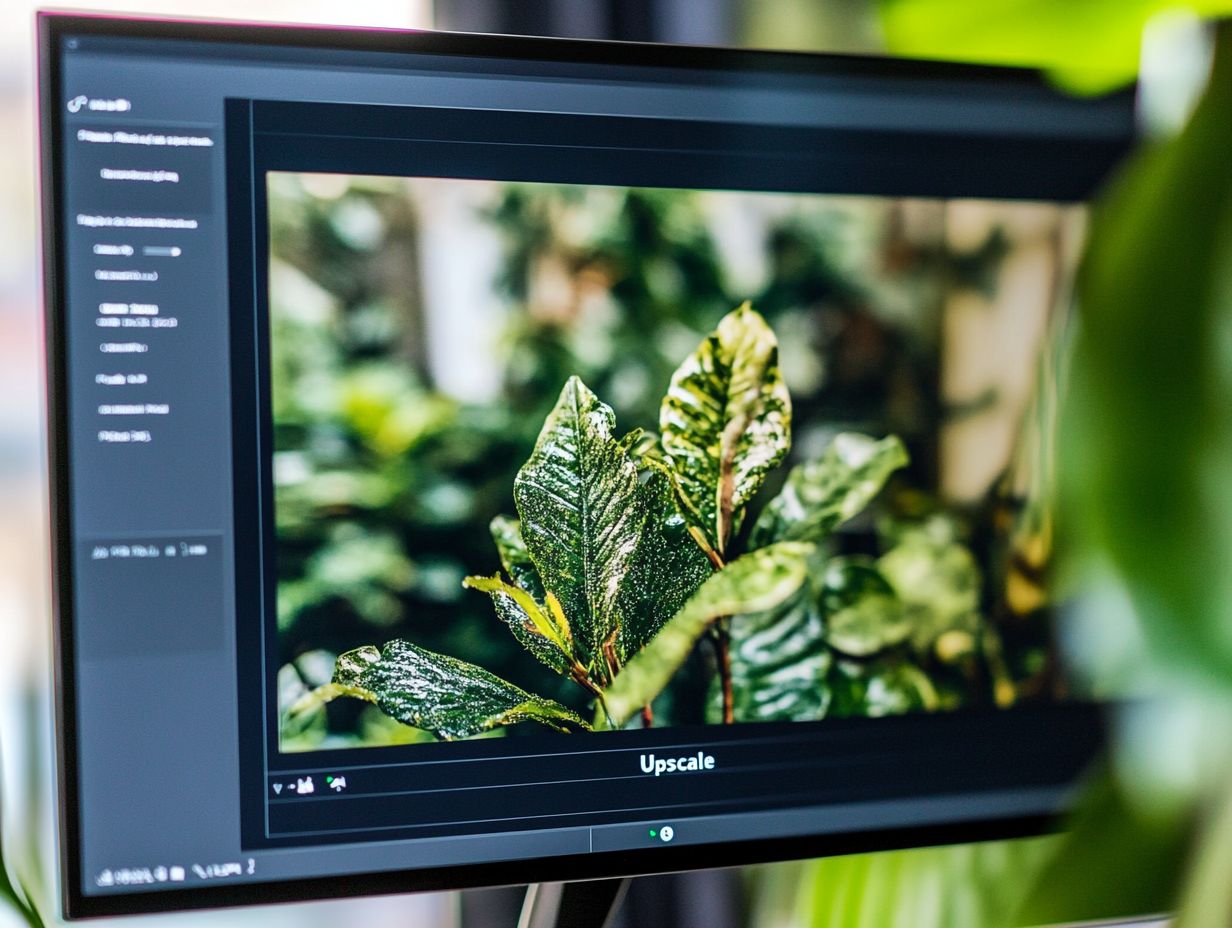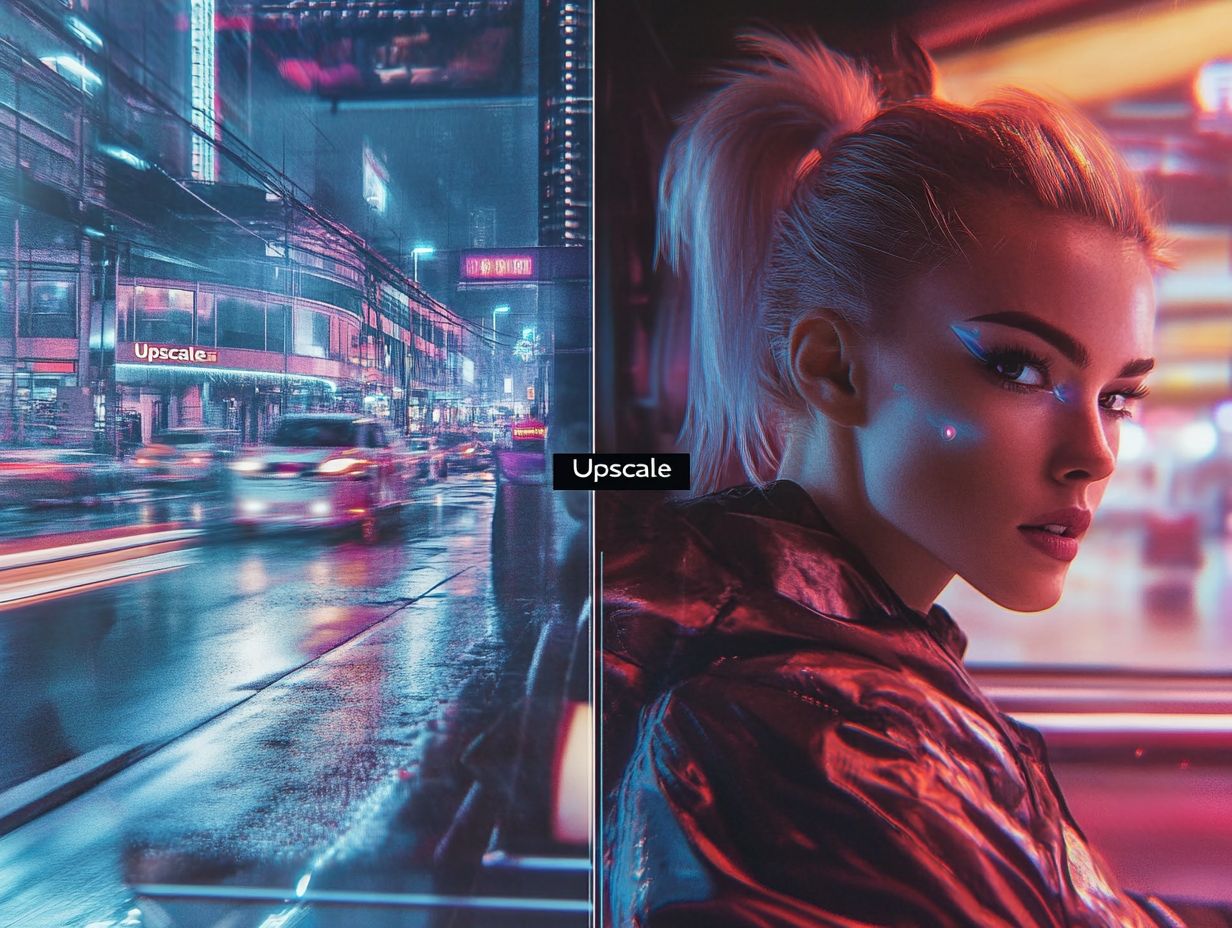How to Upscale an Image Using AI?
In today’s digital landscape, high-resolution images are essential for everything from professional photography to social media content. But what can you do when your images do not meet the quality you desire?
This is where image upscaling comes in a transformative process that enhances the resolution and clarity of your visuals. With the advancement of new technologies, upscaling has significantly evolved, offering a variety of methods and tools that deliver stunning results.
In this article, we will delve into the details of image upscaling, exploring how it works, its benefits and limitations, and the best tools available to enhance your images. Whether you are an amateur enthusiast or a seasoned professional, mastering the art of upscaling can be a game-changer for your visual content.
Contents
- Key Takeaways:
- What is Image Upscaling?
- How Does AI Upscaling Work?
- Why Use AI for Image Upscaling?
- What Are the Benefits of AI Image Upscaling?
- What Are the Limitations of AI Upscaling?
- How to Upscale an Image Using AI?
- What Are the Best AI Image Upscaling Tools?
- Frequently Asked Questions
- Can AI really improve the quality of an image?
- What is the process for upscaling an image using AI?
- Is upscaling an image the same as resizing?
- Can I upscale any image using AI?
- Are there any limitations or drawbacks to upscaling with AI?
- Is it possible to reverse the upscaling process if I am not satisfied with the results?
Key Takeaways:
What is Image Upscaling?
Image upscaling is the process of enhancing the quality of low-resolution images by improving their resolution and detail, thereby converting them into high-resolution images suitable for various applications.
This enhancement is achieved using AI image upscalers, which analyze the original image to facilitate significant improvements in image quality, including the recovery of fine details and textures that may have been lost during the initial capture.
By employing advanced artificial intelligence techniques, these tools can upscale images with minimal loss of visual integrity.
How Does AI Upscaling Work?
AI upscaling refers to the process of utilizing algorithms and artificial intelligence techniques to analyze low-quality images and intelligently reconstruct them into higher-quality versions. This technology employs complex AI models that learn from high-quality training datasets to understand the content of images, allowing them to enhance details and textures accurately while also applying noise reduction methods, which are essential for producing clear upscale images.
The system requirements for AI upscaling vary depending on the software being used, such as Topaz Labs’ Gigapixel AI or other popular photo enhancement applications. These requirements ensure that the upscaling process is performed under optimal conditions, yielding the best possible results.
Deep learning principles play a crucial role in AI upscaling algorithms, enabling the software to identify various elements within an image, including the background and the subject. Tools like Gigapixel AI utilize convolutional neural networks (CNNs) to predict the appearance of missing pixels, resulting in realistic enhancements.
Features such as Face Recovery AI are particularly important for portrait photography, as they refine facial details without introducing artifacts. Additionally, noise reduction algorithms improve clarity by eliminating unwanted visual distortions, ensuring that the enhanced output is suitable for a wide range of applications, from professional photography to digital artwork.
What Are the Different Types of AI Upscaling?
Various types of AI upscaling methods are available, each utilizing different AI models and techniques tailored to the specific needs of the image and the functionalities of the software. These methods include specialized algorithms that focus on batch upscaling multiple images simultaneously, as well as tools designed for the real-time enhancement of video content. Learning resources, such as video tutorials, assist users in selecting the appropriate method based on their requirements, whether for photography, media production, or e-commerce applications.
Some popular techniques include convolutional neural networks (CNNs), which excel at preserving fine details during the upscaling process and are particularly effective for restoring old photographs. Another technique, generative adversarial networks (GANs), generates new details that were not present in the original image, making them useful for artistic projects.
Additionally, some software tools are specifically designed for batch upscaling, enabling users to quickly and efficiently enhance large volumes of images. These applications often include comprehensive video tutorials to help users manage their upscaling projects effectively.
Why Use AI for Image Upscaling?
The benefits of artificial intelligence (AI) for image upscaling are evident in various fields, particularly in enhancing image quality. Today’s AI image upscaling tools can produce high-quality results from low-resolution pictures. These advancements have led to the development of image upscalers and photo enhancers that allow users to improve the clarity, details, and textures in their images without the loss of artifacts that often accompany manual enhancement techniques.
In today’s visual-centric world, users expect stunning images across multiple domains, including photography, media, and e-commerce. AI image upscalers have emerged as valuable tools in these areas. For instance:
- Photography: Many photographers utilize these tools to elevate their images, transforming average photos into breathtaking works of art suitable for display or sale.
- Media: Journalists and media organizations rely on AI image upscaling to generate high-quality images that enhance their reporting.
- E-Commerce: Online retailers require clear and appealing product images to attract customers, and AI image upscalers enable them to achieve this.
Additionally, numerous AI models can upscale images in batches, allowing organizations to efficiently process large volumes of images while maintaining visual quality across all platforms.
What Are the Benefits of AI Image Upscaling?
AI image upscaling offers several benefits, including significantly enhanced image quality, improved details and textures, and effective noise reduction. These advantages have made it a popular choice among photographers and media professionals.
The upscaling process allows users to transform low-quality images into high-resolution works suitable for various applications, ensuring that every detail is preserved and enhanced.
Furthermore, as AI technology continues to advance, these benefits are becoming increasingly accessible to users of all skill levels, providing powerful tools for anyone seeking to enhance their visual content.
What Are the Limitations of AI Upscaling?

The limitations of AI upscaling stem from the inaccuracies of AI models and the final image settings. While these tools can enhance visual content, they may misinterpret details, resulting in artifacts or unnatural appearances in the upscaled images.
The effectiveness of the upscaling process largely depends on the quality of the original image and the specific software settings employed. Therefore, the final outcomes of AI upscaling should be evaluated with caution.
Users must be discerning in selecting images for enhancement, avoiding those with low resolution or poor clarity, as these will likely produce unsatisfactory results. Although AI algorithms are advanced, they can struggle with noise or blurred areas of an image, leading to unexpected and undesirable results.
Artifacts such as banding, pixelation, and unnatural textures can become more pronounced in certain situations, detracting from the overall quality of the upscaled images. Consequently, it is crucial to understand the capabilities and limitations of the software, as well as to carefully manage image settings, in order to maximize enhancement while minimizing drawbacks.
How to Upscale an Image Using AI?
The process of AI image upscaling consists of a series of steps that utilize advanced AI image upscalers to convert low-resolution images into high-resolution versions. It begins with selecting the appropriate photo enhancement software, such as Topaz Labs Gigapixel AI, which includes features designed to improve image quality.
Once the software is chosen, the upscaling process involves:
- Preparing the original image
- Selecting the appropriate settings
- Processing the image
- Obtaining the final upscaled result
Step 1: Choosing the Right Software or Tool
When selecting AI upscaling software, several important features should be considered, including user-friendliness, the types of adjustments allowed, trial versions, and compatibility with existing image formats. The choice of software or tool for image upscaling significantly impacts the results, as different AI image upscalers offer varying features and capabilities tailored to specific needs.
Top AI image upscaling tools come with distinct features. For example, Topaz Labs Gigapixel AI is a powerful option that enhances image quality while providing an easy-to-use interface for fine-tuning adjustments. Many image upscaling tools offer trial versions, allowing users to explore their features before making a financial commitment.
- User-Friendliness: The ideal AI upscaling software should be intuitive and easy to navigate, even for those without technical expertise. These tools are designed to deliver optimal results with minimal effort. The simpler the software, the more likely users will be able to utilize its full capabilities without needing advanced technical skills.
- Adjustments: The best image enhancement software provides a variety of adjustment options, such as the level of upscaling and specific modifications tailored to different image types. For instance, Let’s Enhance allows users to choose between upscaling for printing or web viewing, as well as applying filters designed for various photo categories. AI upscalers like Adobe Photoshop offer advanced resizing options and sophisticated algorithms for photo enhancement, along with basic adjustments such as brightness, contrast, and color balance.
- Trial Versions: Trial versions of AI upscaling software are invaluable, offering potential users the opportunity to explore features and evaluate performance before committing financially.
- Compatibility: Many users have existing images in specific formats that they wish to upscale, so compatibility with those formats is essential.
- Processing Speed: The time required to process an image can vary significantly between tools and may be a critical factor for some users. Processing speed typically depends on the number of available adjustments and the complexity of the algorithms employed. More complex algorithms tend to increase processing time, as do additional adjustments.
Step 2: Preparing the Image for Upscaling
Preparing the original image is a crucial step in the upscaling process. This stage ensures that the image is in the correct format and resolution while making preliminary adjustments using the selected software to enhance its overall compatibility with the upscaling process.
It is essential to consider the appropriate image settings so that AI enhancement can preserve the original image’s best features. The image format should be thoroughly checked, with JPEG and PNG being common formats that are often more compatible with AI tools.
Additionally, the resolution needs to be assessed, as images with lower pixel counts may not upscale well and could lose quality. Preliminary adjustments, such as sharpening or brightness alterations, can further prepare the image for processing.
Understanding the specific settings of the upscaler, including scaling factors and noise reduction options, is also important, as these settings play a significant role in the overall enhancement journey.
This preparatory phase not only paves the way for effective upscaling but also maximizes the potential of the AI technology used.
Step 3: Selecting the Upscaling Parameters
Selecting the appropriate upscaling parameters is crucial for customizing the enhancement process to achieve the highest quality results for the original image. The parameters chosen influence not only the final appearance but also the sharpness, clarity, and noise levels of the enhanced image.
For example, within Gigapixel AI, users can select scaling factors that range from 2x to 6x, determining how much larger the final image will be. Additionally, the software allows for adjustments to noise reduction settings, which is particularly important for lower-resolution images, as excessive noise can compromise the final result.
The detail enhancement setting also plays a vital role in preserving fine details and textures, which are essential for maintaining the integrity of the original photo. Ultimately, a proper understanding and configuration of these parameters can significantly enhance the outcome, resulting in an image that is not only larger but also more vibrant and true to the original source.
Step 4: Processing the Image with AI Upscaling
Processing an image with AI upscaling refers to executing the chosen parameters in a selected photo enhancement software to create an upscaled version of the image. During this phase, AI models analyze the original image while applying user-specified adjustments and enhancements. This is where the most significant changes to image quality occur, as the raw potential of AI image upscalers is unlocked, transforming low-quality images into high-resolution works of art.
Throughout the processing phase, users can expect sophisticated algorithms to engage in deep learning, meticulously examining every pixel to enhance textures, colors, and details. The AI leverages vast datasets to recognize patterns, allowing it to enhance features such as sharpness and clarity intelligently, without introducing artifacts or distortion.
This meticulous attention to detail not only boosts visual appeal but also preserves the essence of the original image, ensuring that skin textures in portraits remain natural and backgrounds do not appear overly smoothed. Ultimately, this nuanced processing phase is crucial for delivering images that are not only larger but also richer in detail and artistry.
Step 5: Fine-tuning the Upscaled Image

Fine-tuning the upscaled image is the final step in the AI upscaling process, allowing users to manually adjust image parameters to enhance quality even further. After processing, most software provides options to refine details, correct any anomalies, and ensure that the upscaled image aligns with the user’s expectations.
This fine-tuning phase is crucial for achieving a balance between detail preservation and aesthetic appeal, making it an essential component of the image upscaling workflow. During this stage, users can adjust elements such as brightness, contrast, and color saturation, which are vital for enhancing the overall vibrancy of the image.
Applying sharpening filters can help refine edges, while noise reduction tools eliminate unwanted graininess that may have been introduced during the upscaling process. Users should also consider local adjustments, which allow for targeted enhancements in specific areas of the image.
Taking the time to explore these options can result in stunning, polished outcomes that not only meet but exceed the original vision. Therefore, patience and attention to detail during this phase are key to transforming an upscaled image into a true masterpiece.
What Are the Best AI Image Upscaling Tools?
The top tools for AI image upscaling are Topaz Labs Gigapixel AI, Let’s Enhance, Waifu2x, ESRGAN, and PhotoZoom Pro.
Each of these tools offers unique advantages and is designed to cater to different audiences.
1. Topaz Labs Gigapixel AI
Topaz Labs Gigapixel AI is a powerful photo enhancer that utilizes advanced AI models to deliver exceptional resolution and quality improvements for images. The software upscales images while preserving fine details and textures, making it an essential tool for photographers and media professionals who demand the highest quality results.
Gigapixel AI’s sophisticated AI models analyze images at the pixel level, reconstructing missing information as they enhance resolution. This process not only produces sharper images but also restores details that are often lost, making it ideal for prints and large-scale displays.
Users have praised the software for its efficiency and streamlined workflow, which allows them to save time while enhancing their visual content. For example, one photographer noticed an immediate improvement in the texture and quality of his landscape images, crediting his success to Gigapixel AI’s transformative capabilities.
Case studies have demonstrated its effectiveness across various fields, highlighting that the software is a vital component in the workflows of creative professionals seeking to elevate their work.
2. Let’s Enhance
Let’s Enhance is a popular AI image upscaler that offers users an accessible and efficient platform for improving image quality. This software employs advanced AI algorithms to upscale images while preserving essential details and textures, making it suitable for both amateur and professional photographers.
Its user-friendly approach allows individuals to enhance their images easily without requiring extensive technical knowledge. The intuitive interface of Let’s Enhance simplifies navigation, ensuring that both tech-savvy users and those with minimal experience can achieve stunning results without feeling overwhelmed.
With features like batch processing, users can enhance multiple images simultaneously, saving valuable time while still obtaining high-resolution outputs. The platform also supports a variety of formats, allowing artists and marketers to seamlessly integrate enhanced images into their projects.
Its effectiveness in producing sharp, vibrant visuals has made it a preferred tool for influencers and e-commerce businesses seeking to elevate their visual content in a competitive digital landscape.
3. Waifu2x
Waifu2x is an AI image upscaling tool specifically designed for enhancing images, particularly in the anime genre. It employs highly effective AI models that focus on noise reduction and detail enhancement, making it one of the most popular AI upscalers available.
Users appreciate Waifu2x for its ability to reduce noise and enhance details while carefully preserving the vibrant colors and intricate elements that anime enthusiasts love. This free, open-source tool is user-friendly and allows individuals to transform low-resolution artwork into stunning high-definition visuals.
Waifu2x is widely utilized for both personal projects and professional work, such as prints and digital portfolios. Its dual capability to reduce noise, especially in older or lower-quality images, sets it apart from other tools, resulting in a cleaner and sharper final product. This encourages artists to explore new creative possibilities in their visual media.
4. ESRGAN
ESRGAN (Enhanced Super Resolution Generative Adversarial Networks) is an advanced AI model recognized for its exceptional image upscaling capabilities, producing high-quality results. This software leverages powerful deep learning techniques to improve image quality, making it suitable for a variety of applications, including professional photography and media production.
ESRGAN is particularly valued for its ability to reconstruct fine details in images, setting a high standard in the field of AI image upscalers. The model employs a dual architecture that facilitates the generation of realistic textures, significantly enhancing traditional upscaling methods.
Its strengths extend beyond image enhancement; it seamlessly integrates into workflows for projects ranging from digital art to game development. For example, photographers can upscale their images without losing detail, thereby enhancing their portfolios, while media companies use ESRGAN to restore vintage films, revitalizing classic footage.
Whether applied in commercial settings or creative endeavors, the transformative impact of this technology is evident in its widespread adoption and the stunning image quality it helps achieve.
5. PhotoZoom Pro

PhotoZoom Pro is a renowned image upscaling software that utilizes AI technology to enhance image quality during the upscaling process. The tool offers a variety of features for adjusting image parameters and has demonstrated that significant improvements can be achieved with original images. PhotoZoom Pro has gained a reputation as a reliable resource for both amateur and professional users seeking to enhance images with minimal effort.
PhotoZoom Pro Features and Advantages
- Easy-to-Use Interface: The user-friendly interface of PhotoZoom Pro allows for seamless navigation, making it accessible for individuals who may not be tech-savvy.
- Powerful Algorithms: The software is distinguished by its powerful algorithms that preserve detail and clarity, even when images are enlarged to extreme sizes.
- Broad Usage: Its capabilities benefit various fields, including photography, graphic design, and digital marketing, enabling users to easily enhance visuals for professional presentations or social media content.
- Batch Processing: The batch processing feature is a significant time-saver, allowing multiple images to be adjusted simultaneously, making it an efficient tool for busy professionals.
Frequently Asked Questions
Can AI really improve the quality of an image?
Yes, AI technology has advanced to the point where it can significantly enhance the resolution and quality of an image.
What is the process for upscaling an image using AI?
The first step is to find a reliable AI upscaling software or tool. Then, upload your image and select the desired output resolution. The software will use algorithms to analyze and enhance the image, resulting in a higher quality version.
Is upscaling an image the same as resizing?
No, upscaling involves using algorithms to add extra pixels to an image, resulting in a higher resolution and improved quality. Resizing simply changes the dimensions of an image.
Can I upscale any image using AI?
Yes, you can upscale any type of image, including photographs, graphics, and digital art. However, the quality of the output will depend on the original quality of the image.
Are there any limitations or drawbacks to upscaling with AI?
While AI upscaling can greatly improve the quality of an image, it is not a perfect solution. In some cases, the results may not be as expected, and there is always a risk of losing some original details or introducing artifacts.
Is it possible to reverse the upscaling process if I am not satisfied with the results?
In most cases, no. Once an image has been upscaled using AI, it is difficult to revert back to the original quality. It is important to carefully choose the right settings and software before beginning the upscaling process.







